[English] 日本語
 Yorodumi
Yorodumi- PDB-7ryc: Oxytocin receptor (OTR) bound to oxytocin in complex with a heter... -
+ Open data
Open data
- Basic information
Basic information
| Entry | Database: PDB / ID: 7ryc | ||||||
|---|---|---|---|---|---|---|---|
| Title | Oxytocin receptor (OTR) bound to oxytocin in complex with a heterotrimeric Gq protein | ||||||
 Components Components |
| ||||||
 Keywords Keywords | MEMBRANE PROTEIN/NEUROPEPTIDE / HORMONE / GPCR COMPLEX / TRANSMEMBRANE RECEPTOR / OXYTOCIN RECEPTOR / OTR / OT / OXTR / G PROTEIN / OXYTOCIN / VASOTOCIN / MEMBRANE PROTEIN / MEMBRANE PROTEIN-NEUROPEPTIDE complex | ||||||
| Function / homology |  Function and homology information Function and homology informationoxytocin receptor activity / positive regulation of hindgut contraction / maternal aggressive behavior / oxytocin receptor binding / neurohypophyseal hormone activity / V1A vasopressin receptor binding / sperm ejaculation / positive regulation of penile erection / positive regulation of uterine smooth muscle contraction / Vasopressin-like receptors ...oxytocin receptor activity / positive regulation of hindgut contraction / maternal aggressive behavior / oxytocin receptor binding / neurohypophyseal hormone activity / V1A vasopressin receptor binding / sperm ejaculation / positive regulation of penile erection / positive regulation of uterine smooth muscle contraction / Vasopressin-like receptors / regulation of systemic arterial blood pressure by vasopressin / vasopressin receptor activity / maternal process involved in parturition / negative regulation of urine volume / positive regulation of norepinephrine secretion / response to sucrose / drinking behavior / response to ether / positive regulation of prostaglandin secretion / grooming behavior / positive regulation of blood pressure / neuropeptide hormone activity / maternal behavior / positive regulation of ossification / positive regulation of female receptivity / positive regulation of synapse assembly / eating behavior / response to food / male mating behavior / positive regulation of vasoconstriction / response to electrical stimulus / social behavior / response to cAMP / response to retinoic acid / positive regulation of synaptic transmission / neuronal dense core vesicle / cellular response to hormone stimulus / negative regulation of blood pressure / response to prostaglandin E / lactation / muscle contraction / regulation of heart rate / response to progesterone / response to glucocorticoid / secretory granule / response to amphetamine / response to activity / response to cocaine / female pregnancy / response to peptide hormone / memory / Olfactory Signaling Pathway / Activation of the phototransduction cascade / G beta:gamma signalling through PLC beta / Presynaptic function of Kainate receptors / Thromboxane signalling through TP receptor / G protein-coupled acetylcholine receptor signaling pathway / Activation of G protein gated Potassium channels / Inhibition of voltage gated Ca2+ channels via Gbeta/gamma subunits / G-protein activation / terminal bouton / Prostacyclin signalling through prostacyclin receptor / G beta:gamma signalling through CDC42 / Glucagon signaling in metabolic regulation / G beta:gamma signalling through BTK / Synthesis, secretion, and inactivation of Glucagon-like Peptide-1 (GLP-1) / ADP signalling through P2Y purinoceptor 12 / photoreceptor disc membrane / Sensory perception of sweet, bitter, and umami (glutamate) taste / Glucagon-type ligand receptors / Adrenaline,noradrenaline inhibits insulin secretion / Vasopressin regulates renal water homeostasis via Aquaporins / Glucagon-like Peptide-1 (GLP1) regulates insulin secretion / G alpha (z) signalling events / cellular response to catecholamine stimulus / ADP signalling through P2Y purinoceptor 1 / ADORA2B mediated anti-inflammatory cytokines production / G beta:gamma signalling through PI3Kgamma / adenylate cyclase-activating dopamine receptor signaling pathway / Cooperation of PDCL (PhLP1) and TRiC/CCT in G-protein beta folding / GPER1 signaling / response to estradiol / Inactivation, recovery and regulation of the phototransduction cascade / cellular response to prostaglandin E stimulus / heterotrimeric G-protein complex / G alpha (12/13) signalling events / sensory perception of taste / extracellular vesicle / signaling receptor complex adaptor activity / Thrombin signalling through proteinase activated receptors (PARs) / positive regulation of cold-induced thermogenesis / heart development / retina development in camera-type eye / positive regulation of cytosolic calcium ion concentration / GTPase binding / Ca2+ pathway / High laminar flow shear stress activates signaling by PIEZO1 and PECAM1:CDH5:KDR in endothelial cells / G alpha (i) signalling events / G alpha (s) signalling events / phospholipase C-activating G protein-coupled receptor signaling pathway Similarity search - Function | ||||||
| Biological species |  Homo sapiens (human) Homo sapiens (human) | ||||||
| Method | ELECTRON MICROSCOPY / single particle reconstruction / cryo EM / Resolution: 2.9 Å | ||||||
 Authors Authors | Meyerowitz, J.G. / Robertson, M.J. / Skiniotis, G. | ||||||
| Funding support |  United States, 1items United States, 1items
| ||||||
 Citation Citation |  Journal: Nat Struct Mol Biol / Year: 2022 Journal: Nat Struct Mol Biol / Year: 2022Title: The oxytocin signaling complex reveals a molecular switch for cation dependence. Authors: Justin G Meyerowitz / Michael J Robertson / Ximena Barros-Álvarez / Ouliana Panova / Robert M Nwokonko / Yang Gao / Georgios Skiniotis /  Abstract: Oxytocin (OT) and vasopressin (AVP) are conserved peptide signaling hormones that are critical for diverse processes including osmotic homeostasis, reproduction, lactation and social interaction. OT ...Oxytocin (OT) and vasopressin (AVP) are conserved peptide signaling hormones that are critical for diverse processes including osmotic homeostasis, reproduction, lactation and social interaction. OT acts through the oxytocin receptor (OTR), a magnesium-dependent G protein-coupled receptor that is a therapeutic target for treatment of postpartum hemorrhage, dysfunctional labor and autism. However, the molecular mechanisms that underlie OTR activation by OT and the dependence on magnesium remain unknown. Here we present the wild-type active-state structure of human OTR bound to OT and miniG determined by cryo-EM. The structure reveals a unique activation mechanism adopted by OTR involving both the formation of a Mg coordination complex between OT and the receptor, and disruption of transmembrane helix 7 (TM7) by OT. Our functional assays demonstrate the role of TM7 disruption and provide the mechanism of full agonism by OT and partial agonism by OT analogs. Furthermore, we find that the identity of a single cation-coordinating residue across vasopressin family receptors determines whether the receptor is cation-dependent. Collectively, these results demonstrate how the Mg-dependent OTR is activated by OT, provide essential information for structure-based drug discovery efforts and shed light on the molecular determinants of cation dependence of vasopressin family receptors throughout the animal kingdom. | ||||||
| History |
|
- Structure visualization
Structure visualization
| Movie |
 Movie viewer Movie viewer |
|---|---|
| Structure viewer | Molecule:  Molmil Molmil Jmol/JSmol Jmol/JSmol |
- Downloads & links
Downloads & links
- Download
Download
| PDBx/mmCIF format |  7ryc.cif.gz 7ryc.cif.gz | 212.3 KB | Display |  PDBx/mmCIF format PDBx/mmCIF format |
|---|---|---|---|---|
| PDB format |  pdb7ryc.ent.gz pdb7ryc.ent.gz | 157.2 KB | Display |  PDB format PDB format |
| PDBx/mmJSON format |  7ryc.json.gz 7ryc.json.gz | Tree view |  PDBx/mmJSON format PDBx/mmJSON format | |
| Others |  Other downloads Other downloads |
-Validation report
| Summary document |  7ryc_validation.pdf.gz 7ryc_validation.pdf.gz | 690.3 KB | Display |  wwPDB validaton report wwPDB validaton report |
|---|---|---|---|---|
| Full document |  7ryc_full_validation.pdf.gz 7ryc_full_validation.pdf.gz | 696.8 KB | Display | |
| Data in XML |  7ryc_validation.xml.gz 7ryc_validation.xml.gz | 33.7 KB | Display | |
| Data in CIF |  7ryc_validation.cif.gz 7ryc_validation.cif.gz | 52.6 KB | Display | |
| Arichive directory |  https://data.pdbj.org/pub/pdb/validation_reports/ry/7ryc https://data.pdbj.org/pub/pdb/validation_reports/ry/7ryc ftp://data.pdbj.org/pub/pdb/validation_reports/ry/7ryc ftp://data.pdbj.org/pub/pdb/validation_reports/ry/7ryc | HTTPS FTP |
-Related structure data
| Related structure data |  24733MC M: map data used to model this data C: citing same article ( |
|---|---|
| Similar structure data | |
| EM raw data |  EMPIAR-10936 (Title: Oxytocin receptor (OTR) bound to oxytocin in complex with a heterotrimeric Gq protein EMPIAR-10936 (Title: Oxytocin receptor (OTR) bound to oxytocin in complex with a heterotrimeric Gq proteinData size: 4.1 TB Data #1: Unaligned multi-frame micrographs of the oxytocin-oxytocin receptor-miniGq complex [micrographs - multiframe]) |
- Links
Links
- Assembly
Assembly
| Deposited unit | 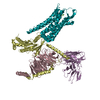
|
|---|---|
| 1 |
|
- Components
Components
-Guanine nucleotide-binding protein ... , 2 types, 2 molecules DC
| #3: Protein | Mass: 36573.531 Da / Num. of mol.: 1 Source method: isolated from a genetically manipulated source Source: (gene. exp.)  Homo sapiens (human) / Gene: GNG2 / Production host: Homo sapiens (human) / Gene: GNG2 / Production host:  |
|---|---|
| #4: Protein | Mass: 37728.152 Da / Num. of mol.: 1 Source method: isolated from a genetically manipulated source Source: (gene. exp.)  Homo sapiens (human) / Gene: GNB1 / Production host: Homo sapiens (human) / Gene: GNB1 / Production host:  |
-Protein/peptide / Protein / Antibody / Non-polymers , 4 types, 4 molecules LOE

| #1: Protein/peptide | Mass: 1008.196 Da / Num. of mol.: 1 / Source method: obtained synthetically / Details: C-C cyclized nonapeptide / Source: (synth.)  Homo sapiens (human) / References: UniProt: P01178 Homo sapiens (human) / References: UniProt: P01178 |
|---|---|
| #2: Protein | Mass: 49627.074 Da / Num. of mol.: 1 Source method: isolated from a genetically manipulated source Source: (gene. exp.)  Homo sapiens (human) / Gene: OXTR / Cell line (production host): HEK-293S / Production host: Homo sapiens (human) / Gene: OXTR / Cell line (production host): HEK-293S / Production host:  Homo sapiens (human) / References: UniProt: P30559 Homo sapiens (human) / References: UniProt: P30559 |
| #5: Antibody | Mass: 27720.795 Da / Num. of mol.: 1 Source method: isolated from a genetically manipulated source Source: (gene. exp.)   |
| #6: Chemical | ChemComp-MG / |
-Details
| Has ligand of interest | Y |
|---|---|
| Has protein modification | Y |
-Experimental details
-Experiment
| Experiment | Method: ELECTRON MICROSCOPY |
|---|---|
| EM experiment | Aggregation state: PARTICLE / 3D reconstruction method: single particle reconstruction |
- Sample preparation
Sample preparation
| Component |
| ||||||||||||||||||||||||||||||||||||
|---|---|---|---|---|---|---|---|---|---|---|---|---|---|---|---|---|---|---|---|---|---|---|---|---|---|---|---|---|---|---|---|---|---|---|---|---|---|
| Molecular weight | Experimental value: NO | ||||||||||||||||||||||||||||||||||||
| Source (natural) |
| ||||||||||||||||||||||||||||||||||||
| Source (recombinant) |
| ||||||||||||||||||||||||||||||||||||
| Buffer solution | pH: 7.4 | ||||||||||||||||||||||||||||||||||||
| Specimen | Embedding applied: NO / Shadowing applied: NO / Staining applied: NO / Vitrification applied: YES | ||||||||||||||||||||||||||||||||||||
| Specimen support | Grid material: GOLD / Grid type: UltrAuFoil R1.2/1.3 | ||||||||||||||||||||||||||||||||||||
| Vitrification | Cryogen name: ETHANE |
- Electron microscopy imaging
Electron microscopy imaging
| Experimental equipment |  Model: Titan Krios / Image courtesy: FEI Company |
|---|---|
| Microscopy | Model: TFS KRIOS |
| Electron gun | Electron source:  FIELD EMISSION GUN / Accelerating voltage: 300 kV / Illumination mode: FLOOD BEAM FIELD EMISSION GUN / Accelerating voltage: 300 kV / Illumination mode: FLOOD BEAM |
| Electron lens | Mode: BRIGHT FIELD / Nominal defocus max: -1.8 nm / Nominal defocus min: -0.8 nm / Cs: 2.7 mm / C2 aperture diameter: 70 µm |
| Specimen holder | Cryogen: NITROGEN / Specimen holder model: FEI TITAN KRIOS AUTOGRID HOLDER |
| Image recording | Average exposure time: 2.497 sec. / Electron dose: 54.8 e/Å2 / Film or detector model: GATAN K3 (6k x 4k) / Num. of grids imaged: 1 / Num. of real images: 40 |
- Processing
Processing
| Software | Name: PHENIX / Version: 1.18.2_3874: / Classification: refinement | ||||||||||||||||||||||||
|---|---|---|---|---|---|---|---|---|---|---|---|---|---|---|---|---|---|---|---|---|---|---|---|---|---|
| EM software |
| ||||||||||||||||||||||||
| CTF correction | Type: PHASE FLIPPING AND AMPLITUDE CORRECTION | ||||||||||||||||||||||||
| 3D reconstruction | Resolution: 2.9 Å / Resolution method: FSC 0.143 CUT-OFF / Num. of particles: 423703 / Algorithm: FOURIER SPACE / Symmetry type: POINT | ||||||||||||||||||||||||
| Atomic model building | B value: 69.03 / Space: REAL | ||||||||||||||||||||||||
| Refine LS restraints |
|
 Movie
Movie Controller
Controller


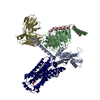

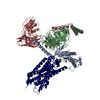
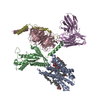


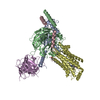


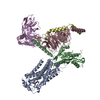
 PDBj
PDBj























